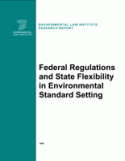
Research Reports
ELI publishes Research Reports available for free download that present the analysis and conclusions of the policy studies ELI undertakes to improve environmental law and policy. These reports contribute to education of the profession and disseminate diverse points of view and opinions to stimulate a robust and creative exchange of ideas. Those publications, which express opinions of the authors and not necessarily those of the Institute, its Board of Directors, or funding organizations, exemplify ELI’s commitment to dialogue with all sectors.
This report examines the role that federal environmental regulations play in the context of the federal-state standard setting relationship. Chapter one provides an overview of how federal regulations relate to standard setting. Chapter two identifies the general policy consequences of allowing state program flexibility. Chapter three examines how federal regulations currently provide for flexibility in this relationship. Chapter four evaluates the techniques used by the federal government to afford or restrain flexibility.
Read More >This 1995 update to our popular series, the study examines the cleanup programs of all 50 states, Puerto Rico, and the District of Columbia. The study provides a snapshot of state statutes, program organization, staffing, funding, expenditures, cleanup standards, and cleanup activities.
Read More >This report examines the International Joint Commission’s existing approaches to protecting shared boundary water resources, evaluates its effectiveness in doing so, and identifies specific, practical proposals for strengthening its capacity to achieve environmental protection.
Read More >This report now provides a follow-up to the Blueprint and reviews the status of various community efforts throughout the Commonwealth to protect natural resources and enhance both economic health and quality of life. Unfortunately, the Virginia Task Force on Sustainable Development concluded its deliberations without making any recommendations about how the Commonwealth can implement sustainable development. Nevertheless, a number of sustainability projects are already under way in Virginia.
Read More >